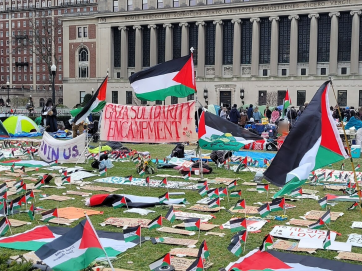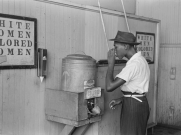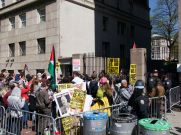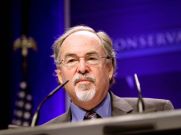Much will be written in the coming days about David Horowitz, who passed away on April 29 at age 86. He will be rightly celebrated as a champion of truth-telling during a long era of lies, collective self-deception, and institutional malfeasance on behalf of anti-American and anti-Western ideologies. Others can tell that story better than I. My memories of him go back to my days in high school in the 1960s when I subscribed for a time to Ramparts, the radical left magazine that David co-founded with Peter Collier. Raised in a communist family, David was a firebrand of the sixties rebellion and a supporter of the Black Panthers, until they murdered his friend Betty Van Patter in December 1974.
David told the story many times, perhaps never more effectively than in his 1997 memoir, Radical Son: A Generational Odyssey. Betty had been a bookkeeper for Ramparts, and David led her to work for the Black Panthers. Apparently, she learned more about their finances than they wanted. She “disappeared” in December. Her corpse wasn’t found until mid-January in San Francisco Bay, with her head caved in.
Police never made any arrests in the case, but it was more or less common knowledge that the Panthers had “offed” her. And it was the turning point of David’s life. At age 35, he discovered he could no longer stomach the lies of the left. “I was in a state of internal free fall,” he wrote. “In my entire life I had never experienced a blacker night.” And, “I was forced to confront myself in a way I never had to before. Every escape route I could look to had been close; every act I had committed was irrevocable.” Questions he had smothered crowded in on him.
David’s own account of his transformation is unsurpassed, and those who haven’t read it are missing a testimony that bears comparison to the writings of Solzhenitsyn and Whitaker Chambers’ Witness. He is in the small company of men who returned from the hell of communism, determined to expose its evils.
He came equipped for that task with fierce determination, shrewd intelligence, quick wit, and above all a masterly command of English style. He came into focus for me in the 1989 book Destructive Generation: Second Thoughts About the 60s, which he co-wrote with Peter Collier. The book emerged from a “Second Thoughts Convention” in Washington, D.C. Both the convention and the book struck a chord with the people I was working with in the Boston University administration.
The president of BU, John Silber, was a maverick liberal who believed in Big Government but scoffed at the intellectual shoddiness of the academic left. As a result, he ended up appointing a retinue of “second thoughts”-style figures: quondam sixties activists who had migrated to the right. His provost, Jon Westling, was one such. Westling had gone to jail for participating in civil rights protests in 1963, but by the 1980s, he was under the guiding star of people like Jeane Kirkpatrick. As a newly minted Ph.D. in anthropology in 1987, Westling appointed me as his assistant. I immediately found myself in the company of other staff who looked up to Collier and Horowitz as shining lights.
In remembrance of David Horowitz, such personal elements matter a great deal.
I met him in person for the first time when Provost Westling invited him to speak at Boston University in the mid-90s. We provided heavy security because by that point, David’s presence on campus guaranteed that leftist hecklers would show up in force. David, of course, was unhindered and perfectly willing to reply to those who shouted out their invective at him. He knew their drill.
In 2000, I met Peter Collier for the first time, and he invited me to write what would become my first published book, Diversity: The Invention of a Concept, for Encounter Books. Not long after, I also met David in a more relaxed setting, and he and I became, if not friends, warm acquaintances. We corresponded. I reviewed some of his many books. The publisher, Encounter, was one of the many places David published, and he and Peter remained lifelong friends.
An account of David’s writing career would take a long essay in its own right. I pulled seventeen of his books off my “Horowitz shelf” in my office when I sat down to write this, and I have several more at home, including my well-worn copy of the first edition of Destructive Generation. If you want to understand how and why the academy became possessed by radical anti-American attitudes, that book is still a good place to begin. If you want to know what David did over his long career after his moment of moral awakening, the tribute published on frontpagemag.com is the place to start.
The National Association of Scholars, meanwhile, had become a familiar part of David’s world. He spoke at our national conference in San Francisco (where else?) in 1993, where he crossed swords with Todd Gitlin—a sixties radical, innocent of any second thoughts. David spoke again at our 1997 conference in New Orleans. Steve Balch, the founder of NAS and my predecessor as NAS president, became David’s close ally in the state-by-state fight to pass the Academic Bill of Rights (ABOR) starting in 2004. ABOR was essentially a call to stop discriminating against faculty candidates who dissented from campus orthodoxies. We would have been spared a great deal of today’s turmoil had it been adopted, but it was vilified by the campus left, led by the AAUP, who persistently characterized it as anti-free speech.
Truth be told, there have been few leaders in higher education in the last century more committed to intellectual freedom than David Horowitz. He was a pugnacious fighter who hit hard at the academic and political left because he knew whereof he spoke. But he respected freedom of thought to the very bottom of his soul.
Photo by Cage Skidmore // Flickr // CC BY-SA-2.0













